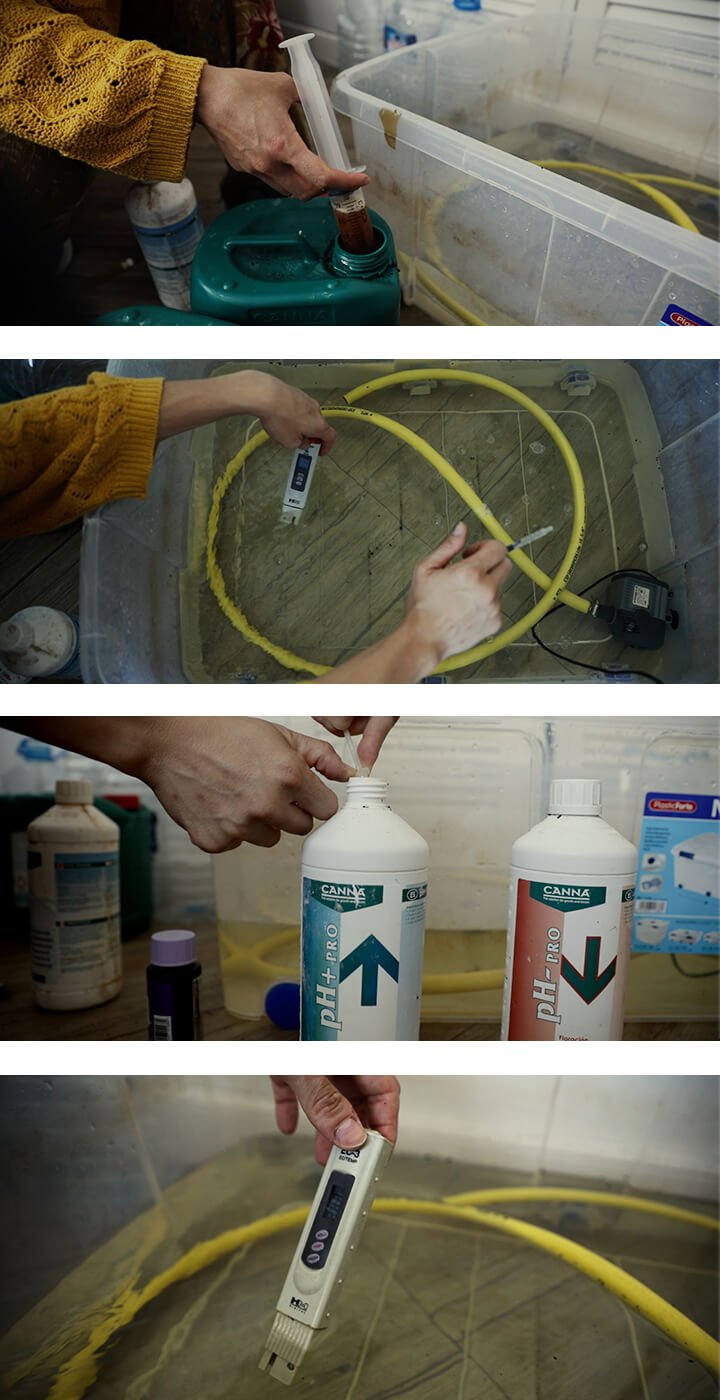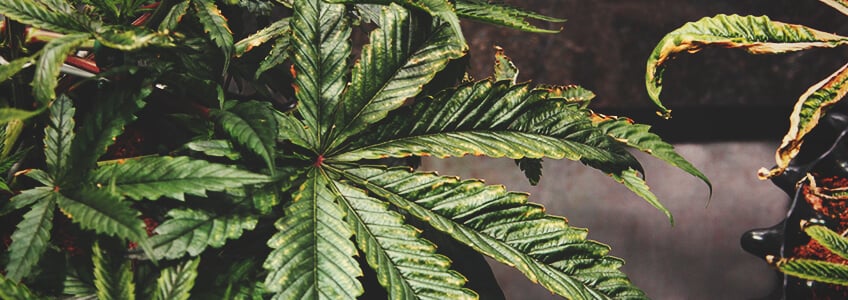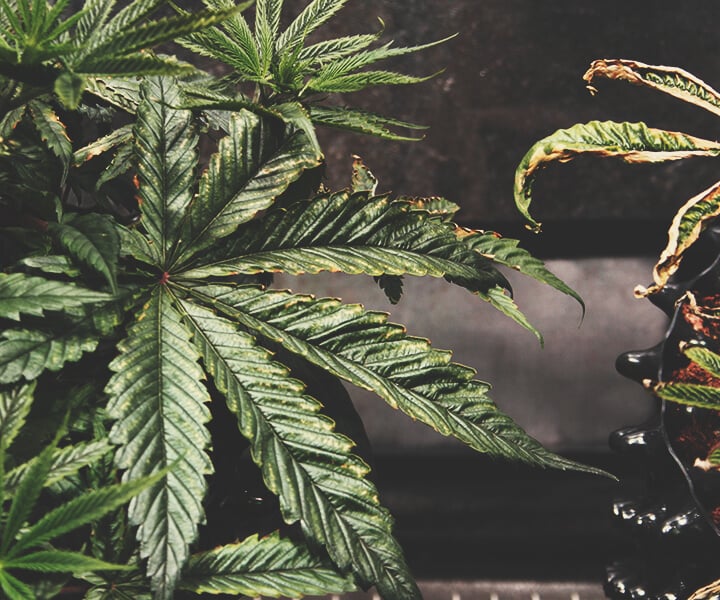Types of Feeding Systems for Marijuana
A full rundown on why and how to feed your cannabis plants.
Contents:
- Understanding cannabis macro and micronutrients
- Not all cannabis fertilisers are made equal
- Nutrient requirements for seedlings, vegging, and flowering weed plants
- How to read a feed chart: how often should I feed my weed plants?
- How to prepare cannabis nutrients
- Recognising cannabis nutrient-related problems
- Organic vs chemical fertiliser for cannabis
- Wrapping your head around cannabis nutrients
All the nutrients needed for cannabis plant development are naturally present in the environment. However, to help your plants develop even faster and produce a better end product, you'll want to feed them with fertiliser—concentrated nutrients.
Below, you'll find all the information you need to know about when, how, and how much to feed your cannabis plants.
UNDERSTANDING CANNABIS MACRO AND MICRONUTRIENTS
Cannabis plants require three nutrients in large quantities. These macronutrients are nitrogen (N), phosphorus (P), and potassium (K), and they form the cornerstone of cannabis plant health. As such, these three nutrients usually feature front and centre on fertiliser products in the form of an NPK ratio. The higher the number for each value, the higher the concentration of that particular nutrient.
However, cannabis needs more than just three nutrients to survive and thrive. It also counts on secondary nutrients like calcium, magnesium, and sulfur to play vital roles in plant growth:
- Calcium is important for cell wall development, can help reduce soil salinity, and improves water penetration when used as a soil amendment.
- Magnesium plays a key role in photosynthesis and carbohydrate metabolism, and also helps with the stabilisation of plant cell walls.
- Sulfur is necessary for the formation of chlorophyll and the production of proteins, amino acids, enzymes and vitamins, and protects plants against disease.
Beyond this, plants also make use of several other nutrients in small quantities (micronutrients) that are nevertheless extremely important. These include boron, chlorine, copper, iron, manganese, molybdenum, and zinc. While these aren't the main nutrients plants use for food, they still play very important roles in various aspects of plant health.
NOT ALL CANNABIS FERTILISERS ARE MADE EQUAL
There are many different brands of cannabis nutrients on the market, and they can differ considerably.
Typically, cannabis fertilisers will vary in the four following areas:
- Nutrient ratio: Different brands use different nutrient ratios they consider optimal.
- Ingredients: Different fertiliser brands can achieve the same nutrient ratios using completely different ingredients, ranging from the most chemical (or "artificial") to the most natural.
- Soil or hydro: Soil nutrients are very different from hydro or soilless nutrient solutions. Make sure you only use fertilisers designed for your growing medium.
- Supplements: Many fertiliser brands also make "supplements". These products typically contain low NPK ratios and instead feature other nutrients designed to boost certain aspects of growth. Some supplements, for example, are essentially molasses.
In general, we recommend you focus more on meeting your plants' demands for macro and secondary nutrients before pumping them full of supplements. Going overboard with nutrients can result in chemical interactions or nutrient burn, which can significantly impact the size and quality of your yield.
Once you've nailed feeding your plants with these core nutrients, feel free to move on to a more complex feeding schedule to produce bigger, more potent harvests.
NUTRIENT REQUIREMENTS FOR SEEDLINGS, VEGGING, AND FLOWERING WEED PLANTS
Cannabis' nutrient requirements change depending on which stage of life it's in.
NUTRIENTS FOR CANNABIS SEEDLINGS
Cannabis seedlings get all their nutrients from their seed, and absorb water via their leaves as their root system develops (that's why it's important to keep them in a warm, humid environment).
You won't need to start feeding your seedlings until they're about 3–4 weeks old, at which point they'll have developed 3–4 true leaves, thus entering the vegetative growth phase.
NUTRIENTS FOR VEGETATIVE CANNABIS PLANTS
Some growers opt to start their plants off on a light 2:1:2 fertiliser (there's that NPK ratio) for one week just when their seedlings start to enter their vegetative growth phase. This step can be a great way to introduce your plants to their fertiliser and avoid nutrient burn. However, some growers see great results immediately starting their plants on a 4:2:3 fertiliser to kickstart growth.
By the mid-vegetative phase (roughly 6 weeks after germinating), you'll want to aggressively increase your plants' nutrients to help them develop strong, healthy foliage. Most growers opt for a 10:5:7 fertiliser by this stage.
| N | N | N | N | N | N | N | N | N | N |
| P | P | P | P | P | |||||
| K | K | K | K | K | K | K |
These heightened levels of nitrogen will help your vegging plants produce luscious, green foliage and develop plenty of bud sites in time for flowering.
Towards the end of the vegetative phase, it's a good idea to start lowering your nitrogen levels and preparing your plants for the switch to their bloom booster. Most growers use a 7:7:7 fertiliser in the last week of the vegetative phase.
| N | N | N | N | N | N | N | |||
| P | P | P | P | P | P | P | |||
| K | K | K | K | K | K | K |
Veg feeding recommendations:
- Early veg: 2:1:2 – 4:2:3
- Mid-veg: 10:5:7
- Late veg: 7:7:7
NUTRIENTS FOR FLOWERING CANNABIS PLANTS
Flowering cannabis plants need less nitrogen and more potassium to promote the growth of big, resinous flowers. During the first two weeks of flowering, most growers feed their flowering plants with a 5:7:10 fertiliser. From here on out, it's common practice to keep dialling up the nutrients on all fronts, always keeping potassium concentrations higher than the rest. By mid-flowering, most growers will be using a 6:10:15 nutrient solution.
| N | N | N | N | N | |||||
| P | P | P | P | P | P | P | |||
| K | K | K | K | K | K | K | K | K | K |
During the last weeks of flowering, growers will drive down their nutrients to smooth out the transition to the pre-harvest flush. By this stage, it's common to use a milder fertiliser with an NPK ratio of 4:7:10.
| N | N | N | N | ||||||
| P | P | P | P | P | P | P | |||
| K | K | K | K | K | K | K | K | K | K |
Flowering feeding recommendations:
- Early bloom: 5:7:10
- Mid-bloom: 6:10:15
- Mid–late bloom: 4:7:10
- Late bloom: pH balanced flush
HOW TO READ A FEED CHART: HOW OFTEN SHOULD I FEED MY WEED PLANTS?
Most fertiliser brands provide their customers with feed charts. Understanding these charts is the key to providing your plants with the right nutrients at the right time.
A feed chart will typically set out a 12–13-week growing cycle. The weeks of the cycle will usually be listed along the x-axis of the chart, which might also include information like the photoperiod for each week and more.
Most importantly, your feed chart will outline what nutrients to give your plants, in what ratio, during the different weeks of their life cycle. Nutrients are typically applied once a week, and most fertiliser brands will provide you with a ratio of feed to water (either in litres or gallons). Some feed charts might also provide you with an EC or PPM range for their solutions. If so, invest in an EC meter and measure your nutrients before feeding for extra accuracy.
Once you've fed your plants, it's always a good idea to check the conductivity or/and PPM of your soil to ensure your plants are absorbing nutrients properly.
HOW TO PREPARE CANNABIS NUTRIENTS
A potential nutrient slip-up, after all, can completely thwart your harvest. But feeding your cannabis plants can be very straightforward. Just follow these steps:
- Prepare your water. If possible, heat your water to about 19 – 21 °C to increase absorption by the roots.
- Add your nutrients according to the instructions on your fertiliser, and stir. Use a PPM or EC meter to get exact readings.
- If necessary, adjust the pH of your feed using a nitric or phosphoric acid pH down supplement.
- Once your PPM, pH, and temperature are right, feed your plants and measure your runoff using your PPM or EC meter to ensure your plants are taking up their nutrients properly.


THE IMPORTANCE OF PPM, PH, AND WATER TEMPERATURE
EC is abbreviation or electric conductivity, PPM for parts per million.
Both are used for a measurement of how much nutrients are present in your water or grow medium. To avoid over or underfeeding your plants, it's a good idea to always measure EC or PPM of your soil or grow medium to see if it still contains nutrients. If there are nutrients present in your medium at the time of your next feed, subtract your medium's values from values recommended by your feed chart to avoid overfeeding.
pH and temperature are equally important metrics when feeding your plants. If either is off even slightly, your plants might struggle to absorb their nutrients. Hence, whenever it's feeding time, keep your nutrient solution at the pH suggested by your fertiliser brand and your water temperature at 19 - 21°C.
TIPS FOR BETTER FEEDING
Here are some quick tips to ensure feeding goes off without a hitch.
Embrace chelation
Most high-quality nutrients will contain chemical chelates. If you're an organic grower, you can use natural chelates like fulvic and humic acid to help your plants better absorb mineral nutrients like iron or zinc. Chelates work by surrounding positively charged nutrients with a negative or neutral charge, allowing them to pass through the plant pore barrier.
Try foliar feeding
Foliar spraying—spraying cannabis leaves with a fine mist—can be a great way to tackle nutrient deficiencies or pests/disease. It is also particularly effective for short-term feeding with secondary nutrients like magnesium or calcium, or micronutrients zinc, iron, and manganese.
Always flush
Nutrients are super important, but you don't want any of them leftover in your harvested bud. That's why it's important to flush your plants with pH-neutral water for at least one week before harvesting. Flushing forces your plants to consume any leftover nutrients they've stored, resulting in a clean, smooth smoke.
Over or underfeeding can stress and damage your cannabis plants. Make sure you keep your eyes peeled for the following nutrient-related problems.
PH IMBALANCE
- pH issues can be caused by imbalances in your medium, water, and nutrients.
- pH imbalances can dramatically impact the health of your plant and cause many other issues, such as nutrient lockout, deficiencies, and more.
- If left untreated, pH issues dramatically impede the growth of your plants and will drive down both your harvest size and quality.
NUTRIENT BURN
- Nutrient burn is usually caused by overfeeding or nutrient buildup in the grow medium.
- Plants develop dark green leaves with almost neon green tips that bend upwards almost 90°, and deep red, magenta, or purple stems or branches.
- Flowering plants develop yellow calyxes and sugar leaves before dying back rapidly.
- Typically treated by flushing roots with pH-neutral water for at least one week before gradually reintroducing the fertiliser.
- Measuring PPM and EC can help you avoid nutrient burn.


NUTRIENT LOCKOUT
- Nutrient lockout is caused by nutrient buildup around a plant's roots, or by pH imbalances, and prevents them from absorbing available nutrients.
- Nutrient lockout leads to nutrient deficiencies, which can cause yellowing foliage, burnt leaf tips, irregular leaf shape and size, and brown spots. Symptoms vary depending on which nutrients your plant is missing.
- Typically treated with a flush, pH checks, and nutrient adjustments.
OVERFEEDING
- Overfeeding with chemical fertilisers and boosters can burn your plants.
- The highly concentrated nature of chemical fertilisers means novice growers can easily end up overfeeding their plants.
- Telltale signs of overfeeding include dry, burnt-looking leaves with yellow or brown discolouration, burnt edges, and upward bent tips.
- Rookie growers often end up buying more supplements in an effort to remedy existing nutrient problems, which only makes matters worse.
- Overfeeding needs to be treated quickly with a root flush, pH stabilisation, and a new feeding schedule.


NUTRIENT DEFICIENCY
- Nutrient deficiency can be caused by underfeeding, or by nutrient lockout.
- Deficiencies in nitrogen, phosphorus, potassium, or secondary nutrients can cause symptoms like dry foliage, yellow or brown leaves, and discoloured stems.
- Nutrient deficiencies are treated by increasing/introducing more nutrients, or by first remedying nutrient lockout.
Browse Deficiencies
Browse Deficiencies
Browse Deficiencies
ORGANIC VS CHEMICAL FERTILISER FOR CANNABIS
At RQS, we always encourage the use of organic nutrients over chemical fertilisers. Unlike synthetics, organic nutrients are released into the soil and absorbed by your plants much slower, dramatically reducing the chance of nutrient burn or other feeding issues.
Organic nutrients also benefit the soil itself, supporting the development of a rich ecosystem of microorganisms that protect and work in tandem with your plants. Organic soil also gets better with time, making it ideal for outdoor growers. The fact that organic nutrients don't produce toxic runoff also reduces the impact your harvest has on the environment.
And while we're all about organics here at RQS, we do understand that chemical fertilisers also have their pros. First and foremost, they are absorbed much faster, meaning they're better for situations where efficiency is key (like when treating a deficiency, for example).
The fact that synthetic fertilisers are carefully made to exact specific ratios of nutrients also means you have a lot more control over what your plants "eat", and in what doses.
BENEFITS OF ORGANIC NUTRIENTS
- Less impact on the environment
- Boosts soil quality and health
- More sustainable than chemical fertiliser
- Better taste (some say)
BENEFITS OF SYNTHETIC FERTILISER
- Absorbed faster
- Nutrient ratios are dialled-in (more control)
- More accessible
WRAPPING YOUR HEAD AROUND CANNABIS NUTRIENTS
With the right genetics, just enough nutrients and water, and plenty of light, you're well on your way to growing some exceptional weed. Remember, arguably the biggest weapon in your arsenal is experience, so keep honing your skills and reaping the rewards.
Source: https://www.royalqueenseeds.com/blog-how-to-use-cannabis-nutrients-n329
0 Response to "Types of Feeding Systems for Marijuana"
Post a Comment